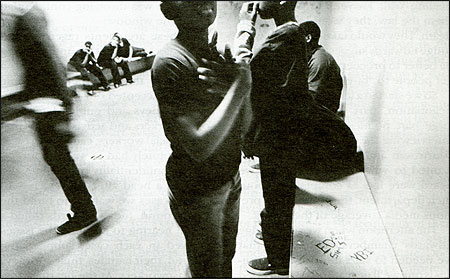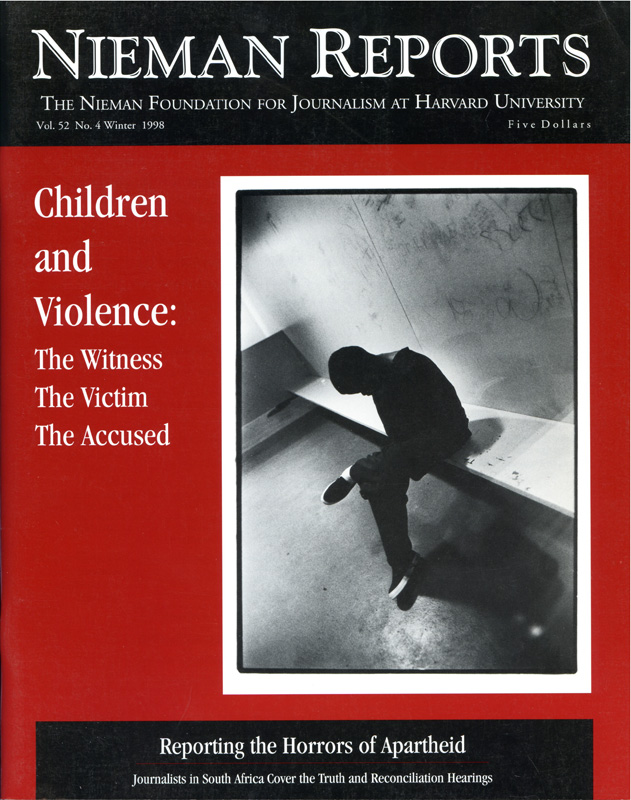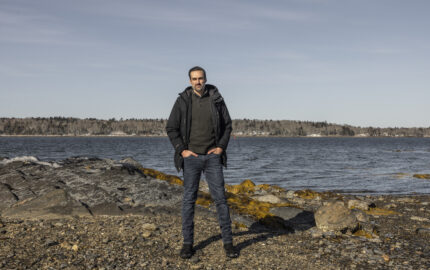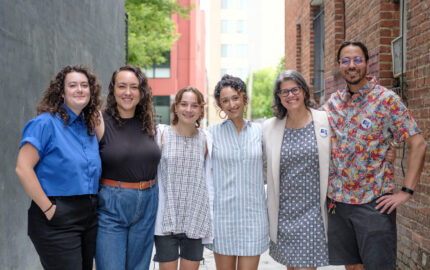
Photo by Pauline Lubens/The Detroit Free Press.
In the summer of 1993, we made an appointment with Judge Leonard P. Edwards, Presiding Judge of the Santa Clara County (California) juvenile court, and described our idea to him: We wanted to spend a year or so in his courtroom. We wanted to shed light on the system that is so often closed to the public by following the children and families that come before him, through not only the courts, but the shelters, the foster homes, the juvenile halls, the drug rehabs and therapy.
In our initial meeting, we emphasized that we didn’t want to do what the media more typically do when covering child welfare and juvenile justice, which is to single-mindedly clobber the system. In most cases, the media appear in these public institutions of last resort only after there is a disaster—a child dies in foster care; a judge releases a delinquent who returns to the street and kills someone. The media then scramble to find the culprit, the person upon whom to lay the blame, whether it’s an incompetent social worker, an overburdened probation department, a harried judge, or a law that doesn’t seem to work.
In telling this story in a book, we would have the luxury of both time and space, luxuries that are denied to most journalists. Our intention was not to focus on the spectacular events, but to target and give voice to the “garden variety” cases that more accurately reflect the day-to-day reality of these interwoven systems.
We approached Judge Edwards because John had gotten to know him while working on several articles for WEST, the Sunday magazine of The San Jose Mercury News. Both of us as reporters had sat in his courtroom observing, with something approaching awe, the flow of humanity, the powerful, elaborate dramas that unfolded there each day. We expected him to be interested in the project. He had long been outspoken in his belief that if the system was ever going to improve, the public must be involved in the process. They must understand the laws, why they are in place, and how well they function. To do this, however, it was clear to us that the public must be able to see the complexities of working with families and children, especially those who are already in trouble, and why there is no “one-solution-fits-all” scenario.
“Sure. Do it. You’ve got to do it,” he said at the end of this meeting.
There was, of course, the “small” matter of confidentiality. We told Judge Edwards that if we were going to tell the comprehensive story of what happened to the children who came into his courtroom, we needed access to more than one or two specific cases. We wanted to come and go at will, to be allowed to read a wide variety of case files, and to speak with as many professionals and families in the system as we could. We needed to be free to hear different viewpoints. And everyone needed to feel free to talk to us.
And we wanted to use real people, real names. We did not want to use composites.
Judge Edwards was more hesitant about acquiescing to this request: “Let me think about that one. When the time comes, we’ll deal with it.” His thinking involved conferring with judicial colleagues around the country. Meanwhile, we did our own legal research and concluded that the framers of the juvenile court system in California had not intended, by their regulations, to keep the press out. We took our “breakthrough” to Judge Edwards. He reminded us that we would be dealing with lawyers. If we showed them the law, they would argue us to death. They would take us up on a writ. Judge Edwards suggested that it would be better to proceed slowly in order to get people to “buy into this project.”
So we started a lengthy process, part negotiation, part persuasion, and a large part political. We spent weeks interviewing the “main players” in his courtroom and telling them why we wanted to write this book. What we heard were lots of complaints, about their department, their bosses and previous media coverage of their work.
The afternoon when we sat in Judge Edwards’ chambers and told him that we needed to start interviewing families is one we’ll never forget. We needed to speak with attorneys and social workers about specific people in specific situations. He spun around in his chair and did something that had never been done in California—or, as far as he knew, in the United States: He issued a broad judicial order that broke open the cocoon of both the Department of Family and Children’s Services (DFCS) and the county’s Probation Department. Our project had begun.
Or so we thought. Quickly, we learned how the habits people acquire can lead to mindsets that are difficult to alter. The first impulse of a sealed-off system is to reject intruders. A district attorney called Judge Edwards to say he didn’t think the judge could issue such an order. He was all for a book—the work he did and the children he represented existed in a shadowland—but somebody would surely take the order up to the appeals court and bring a stop to this project.
Social workers were incredulous. They felt they’d been scapegoated in the press for years. They wanted to talk about specific cases—but were they reading this order correctly? Could they really open their files to outsiders?
The public defender was all for the book. The parents he represented were always under attack, he told us, but social workers had no right to open his clients’ files without their permission. The judge was throwing confidentiality out the window!
As these arguments raged around our project, we kept on interviewing and reading cases. As we did that, a remarkable thing happened. People gradually accepted our presence. District attorneys and public defenders, social workers and activist groups that detest social workers, called with cases we “absolutely had to write about.”
The confidentiality issue finally did come to a head after we selected 10 specific cases we wanted to build the book around. Judge Edwards called a special hearing to examine the issues involved in each case, subpoenaing children, their families, their attorneys and caseworkers. At the hearing, anyone who had objections to our using the information would be heard.
This was an anxious time for us. We had accepted an advance for the book. We had spent almost a year conducting interviews. Now, at these hearings, the entire project could be shut down.
This first hearing was very intense. Judge Edwards’s small courtroom was packed with court insiders. An attorney who had told us in the hallway that she couldn’t wait to read the book was suddenly on her feet, attacking our project. “It’s the precedent that concerns me, your honor,” she explained. “Once you let the press in, you can’t keep them out. You’re opening the door for every tabloid that issues a press card!”
In the end, the first case was opened, on the condition that Judge Edwards read the manuscript for “identifiers”—a street address, an exact occupation that might inadvertently hurt someone innocent. In other hearings, people signed waivers that would allow us to use their real names.
But to our own surprise, it was often us who decided as we wrote the book to change names and slightly alter identities. During the three-year process, we found ourselves walking the line between being journalists and being advocates for people in fragile circumstances. If we were going to err, it would be on the side of protecting people who had let us into their lives. It took great courage for many of them to relive their pasts and share their present. We could find no justification for why they and their children should have to relive them forever, nor would using their real names have made the stories any more true or meaningful.
This experience taught us some valuable lessons that could be applied to reporters who cover these issues as part of their daily job. Just as the juvenile court is considered the least prestigious assignment among judges and attorneys, the juvenile beat often doesn’t hold a lot of prestige within the newsroom. It’s pegged facetiously as the “dead baby beat” or the “good program beat.” In many newsrooms, it’s not even a specific beat. A general assignment writer with little experience is sent to piece together the most recent catastrophe.
Editors need to recognize the need for solid beat coverage and to assign more experienced reporters. And these reporters, once assigned, will find that this is an assignment in which drama is not lacking and stories are waiting to be told. Our own experience reinforced the need for the same reporter to be assigned to write the feature stories about successful social service initiatives or community youth programs and also do the investigations of child deaths and juvenile violence.
Even better would be to have a team of reporters devoted to coverage of all aspects of youth-family issues, weaving together reporting from the arenas of juvenile crime, child welfare, education and welfare reform. We discovered that there are plenty of people who work in these child- and family-focused systems who are eager to talk. But understandably they don’t want to have to start from scratch each time “news” breaks and speak with a reporter who is not able to provide broader context and perspective for their information.
When John returned to his reporting job at The Mercury News, he found he had dozens of new stories to write, stories that could only be found when you are immersed in the system and have earned the trust of the people who work in it. There was a sense among his sources that he was not out to unnecessarily bash the system or the people who worked in it or to defend it. People who he relied on as sources saw his goal as one of helping readers understand troubled families and children. Access, which can be a journalist’s nightmare especially with stories concerning children, no longer was a problem.
“The facts in any case we have are 80 percent on the record,” Judge Edwards says. “A good reporter who knows the system can get the other 20 percent. It’s not hard.”
It’s not hard, if editors and newspapers are willing to give their reporters the time and resources to establish the working relationships and trust they’ll need to move these stories out of the shadows of secrecy.
John Hubner is on the projects team at The San Jose Mercury News and worked for two years as a probation officer before becoming an investigative journalist. Jill Wolfson, a former staff writer at The San Jose Mercury News, is now a freelance writer. They are co-authors of “Somebody Else’s Children—The Courts, The Kids, And The Struggle To Save America’s Troubled Families.” (Hardcover, Crown, 1997; paperback, 1998.)



